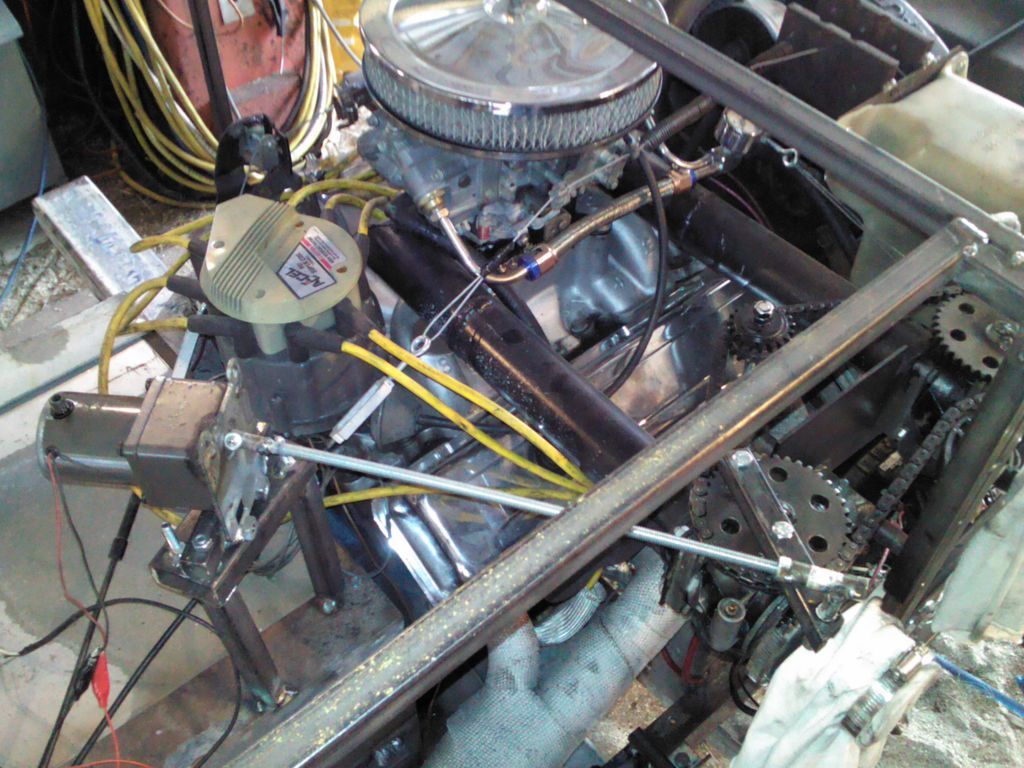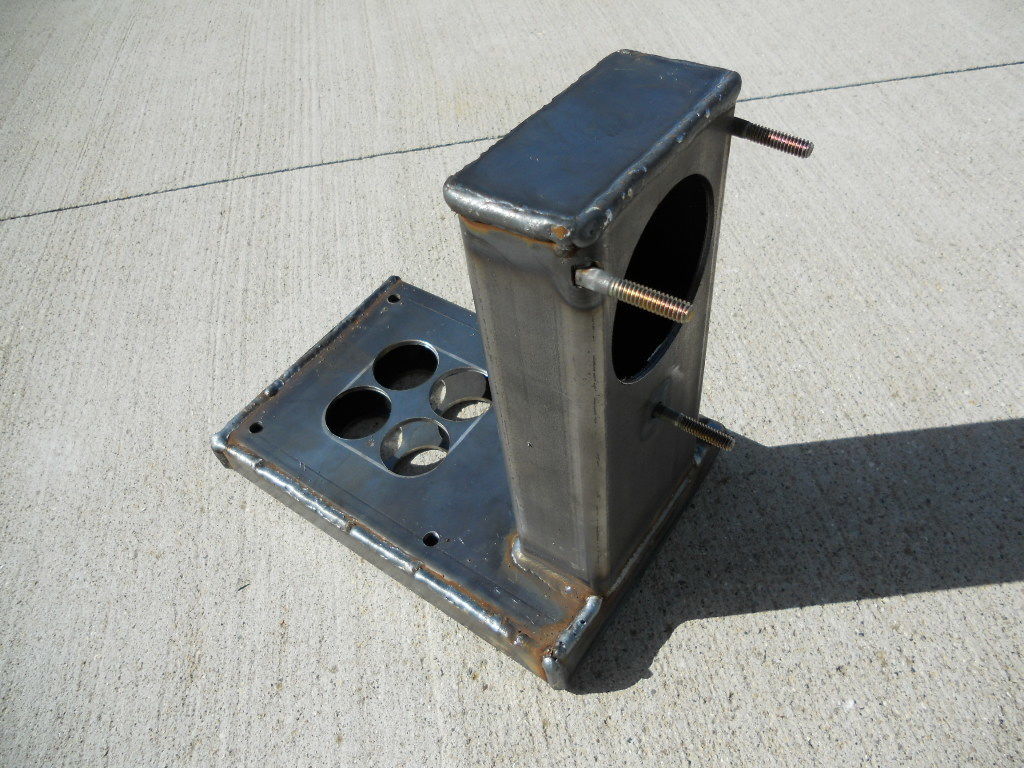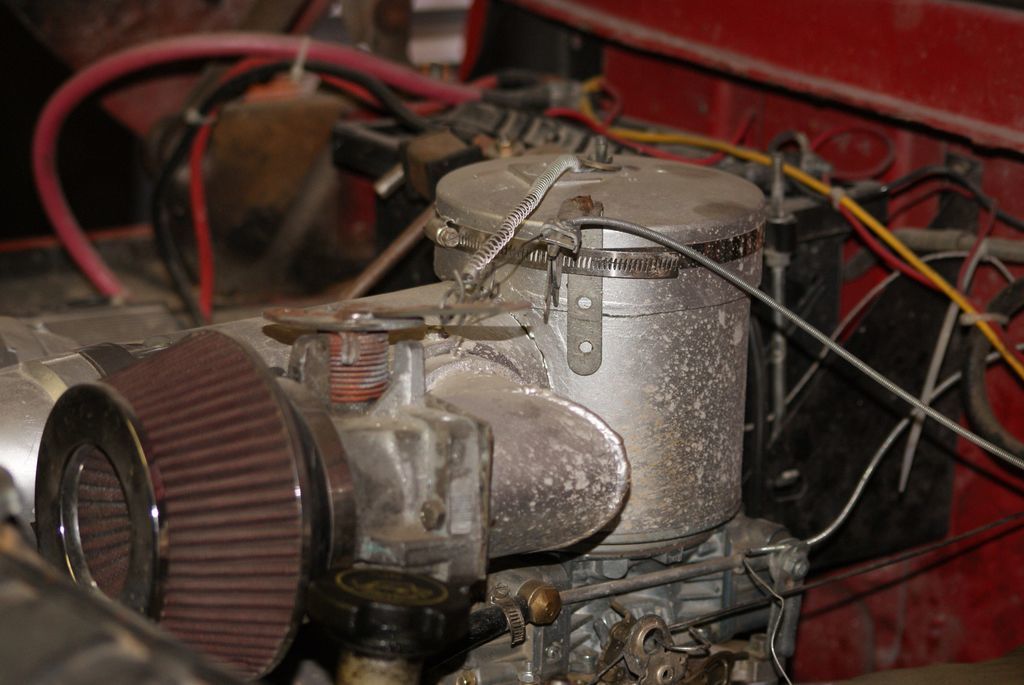Hello all,
I was wondering if there has been any discussion on plenums when carbs are used. I know those who have tried say it is not advisable to run woodgas through the carb because of sticking and clogging issues. Is there anything internally in the plenums that I should know about before I start building one.
Hi Michael,
I have a box under the carburetor. The main thing is that whatever you build has to be flat and true! Use heavier plate that is sure to be flat. Mine was of thin material that tended to buckle. I had to be very careful how I bolted it down - I actually dealt with each layer separately, and supported it from the top and bottom. Use plenty of sealant. The end result is working fine for me, it idles on gasoline OK. There is a lag time from when you open the gasoline throttle till the fuel hits the cylinders. Also you will end up with two throttles, meaning an extra gas pedal in the cab. Don’t try this on a stickshift… unless you have three feet. 
Thanks Chris, I was wondering what you used for the throttle plate. Possibly a injection type butterfly?Also do you have to block off the carb passage to stop draw through carb? Thanks again and I hope all is well. MikeyB
Mikey B
Use two butterflies one on the wood gas and one to mix the air fuel ratio on the wood gas. Leave the carb alone.
I believe this is called hybrid mode.
Hi Michael,
The carb sits on a riser box that we made. It stays closed most of the time, ie no throttle applied. A little gets past with the idle circuit.
On the side of the box I have a throttle body, just a big butterfly valve that I use for the woodgas throttle. I have a second smaller valve I use to blend air into the woodgas to achieve the right mixture.
Here’s a couple photos:
Hi All,
This is the throttle control I made up for my generator. 1/8" thick flat steel cut into a flange that matches carb bolt pattern. A piece of 1/8" 4x4X4" square tube for the riser. A couple of throttle bodies and some emt pipe. Works real good the last picture is of it installed on the generator. Sean
I added another pic. to show how the air is mixed with the woodgas notice how air mixing is done down stream of the throttle bodies.



Interesting! The two throttle bodies linked with sprockets and chain, and then coupled to the spark advance…Does the air/fuel ratio look good on the A/F ratio meter at the rpm you run for the generator? How do you “fine tune” the mixture? Is one sprocket larger than the other one, or is that an optical illusion? Is there much movement when a large load, such as an air compressor hits the ac generator?
Hi Ray
This is a work in progress getting ready for a demo at the end of this month more pics. And info coming soon. Sean
Sean, that really looks great. (And smart) Oh for the freedom to work on a stationary engine with room all around! I really feel like some of the “challenges” of wood gas will be advanced by setups like yours where the advance, the mix, & the load can all be easily “adjusted” in real time, without having to keep your eyes on the road. This is all just about too much fun!
cz
Hi Carl
Thanks for compliment!! You are absolutely correct when testing and experimenting you have to remove all the guess work and go back to basics. Then you will truly know where your at and how to improve the system. And it is lots of fun as well BBB Sean
Looks great! An area I will need to Learn More About!
When doing my '67 I want to be able to run mainly wood gas with gasoline and propane as a back up.
Michael:
You might want to check in with Rom Lemler, host of the Argos event this year. He converted a 300 straight 6 Ford and had a plenum under the carb, said he could not get it to run good on gas, some kind of oscillation, surging, so he took it off, ran the WG through the carb. Probably has to do with the size of the plenum, engine firing sequence, volumes, etc, but something to check into. He’s in this group.
Hello Martin, I did see Rons setup in Argos. It seems to work fine . I ended up building a setup with twin throttle plates and mixers.I am going picking tomorrow to see if I can find matching throttle plates. I will post some pics when I finish.
One thing I did do a little differently was to put in a flapper to isolate the carb from the plenum when in woodgas mode. I thought it would stop carb leaking and possibly better control of the mixture settings.
Thanks for the interest, Good Luck on your project. MikeyB
When wood gas is put in under the carb, the throttle body for the wood gas supply has to be air tight so there are no vacuum leaks. Carburetors will not work well unless they get the full vacuum from the engine because the engine pulls the gasoline into the engine like a siphon. Once we got all the vacuum leaks fixed on the GMC the carb worked fine. The mixing box for the wood gas need not be right under the carb, so the gasoline operation does not have to be affected. In general throttle bodies them selves will leak, they all do. We put GATE valves on the Ranger wood gas lines to stop the leaks so the computer would read properly while running on gasoline. Leaks are a big problem in any new setup. It takes time to chase them all down and stabilize the pipes so they don’t leak again. The newer cars won’t run good if the system leaks anywhere.
Going on ONE year running the Ranger on wood in a few days. The gasifier shows no rust any where. The fire tube looks as straight and good as the day it was put in. The nozzles look brand new, no oxidation or wear from heat.
Hi Martin and Michael;Here are a couple of pics of the carb set ups I have used.
#1, plenum under the carb, I linked the carb throttle to the woodgas throttle body,using a single 2" line, to get the right ratio I kept changing to different holes on the lever on the throttle body until it ran good in all the speed ranges, this worked well but it took some time to find the right ratio, the air mixed under the carb. I drove with one pedal this way. The carb was a simple old single barrel I just turned the fuel off with a switch to the electric fuel pump. This setup would run all woodgas all gasoline or a little hybrid by turning on the fuel pump for a second to get up the big hills or get up to speed in traffic.
#2, I added a 3" line to the carb and used a plenum under the carb again we made the box shallow to keep any turbulance to a minimum when running on gasoline, but this didnt work and it wouldnt run on gasoline or even idle right and on woodgas it ran about the same as the old one.
#3, I then took the plenum out and put the Holly down on the manifold and brought the woodgas into the top of the carb and added the air up stream instead of mixing right at the carb. When I did this it gained about 5 mph and ran better. It also ran on either gasoline or wood and also hybrid a small amount like the first.

You guys have convinced me that I did things right all along, using the stock butterfly(s) and feeding into the air cleaner. I just finally had to get rid of paper filters and go to foam filters and on my current setup I rely on the hay filter and tap in between the stock throttle body the stock air cleaner. It was always a drag waiting for the gasoline to get sucked out of the bowl of the old carbs. I would adjust the floats so they would only let in a tablespoon or so. I’m currently turning off all power to the fuel pump and injectors so it is one or another. I always had problems with carborator idle circuits but fortunately some of the older cars had an idle solenoid to prevent dieseling. As soon as the weather cools down a bit and we get some rain, I can play again. I need to come up with a dribble setting for the 97 cavalier. The circuit draws 5 amps or so and this converts to an equivalent ohmage of 2.4. Based on that if I stick another 2.4 ohms in the circuit it will drop the voltage to the pump to 6 volts and to 2.5 volts at the injectors. I figure I am going to have to go way lower than that to get it to dribble in. The key thing will be to keep the pump from stalling. I think Don M measured his potentiometer at 250 ohms. That seems too high to me … Guess I’ll find out when it cools off what works. I measured 2 feet of coiled nichrome wire at 52 ohms so will get the clip leads and find the sweet spot. I need to buy another few 49 cent light switches … Sorry but all of my carborated cars are unsafe to drive on the highway now so I have had to move on to newer stuff … They are just show pieces now … I’ll report when I can get things done safely. Mike
Sean, That is quite the generator setup … Lots of things to move and shake with it. I wish you the best but of course know it will work just fine … I have never messed with AC alternators. I have an old civil defence 300 watt Onan here that I play with from time to time. It runs my tube ham radio stuff just fine. M
Well the best carb is NO carb. Go under and you get leaks and go over you get passageways fouled. You can’t win. I chose to fight the leaks over fighting the carbon, and I think that has worked out. But if you’re buying a truck to convert - get one without a carburetor! And TBI is not much better, you really want MPFI - get those injectors down deep out of the way. I guess the next thing will be direct injection, a la diesels? Some cars already have this. Will be a LONG time before I get one as a hand-me-down though.
Hi Ray,
The two sprockets are connected to a screw drive electric motor for throttle. The spark advance has it’s own separate screw drive and motor to test and dial the system in with the cover on. Right now I don’t have a computer built to control anything still working on that. For now everything is done with switches manually just to practice. Even with the manual control it is still very easy to run and start up with no gasoline. So far I haven’t hit it with a large enough load to through the settings off. Sean
Sorry I had more videos but the sound was messed up this is the only one that came out half way decent
Thanks Sean, The video link was to my home page. Did you mean this video where you were running the generator on gasoline in an attempt to dry the paint? http://www.youtube.com/watch?v=FHJeBN6IqNc&feature=plcp




